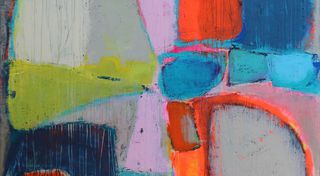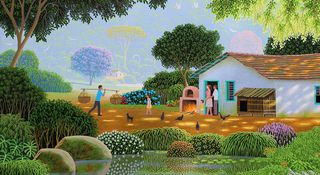

India
• 1938
Biography
The district of Madhubani (on the border with Nepal, in the state of Bihar, North India), once the kingdom of Mithila, is the home of an ancestral tradition known as Mithila Painting. Performed by women, its lore and techniques are passed down from mother to daughter.
Each caste has its own systems of representation. The higher castes have been encouraged by the Indian government to transcribe their ritual but ephemeral art on permanent supports, such as paper, since the 1940s. Works on paper painted by low-caste women appeared for the first time during the 1970s.
Between 1972 and 1978 the German anthropologist Erika Moser visited the Madhubani district on several occasions to study and film the crafts and rituals of the Dusadhs, who are part of the caste known in the West as the Untouchables. Moser encouraged the Dusadh women to paint on paper with the aim of generating extra income.
Unfamiliar with the complex graphical signs used by the Kayasthas and Brahmins, the Dusadh women took inspiration from their own traditions and developed three styles and techniques that are specific to them. The first was initiated by Chano Devi and takes tattoos as its stimulus. This style is now known by the name godhana (godna means tattoo). These paintings are largely composed of lines, concentric circles, and circles filled with motifs taken from the flora and fauna.
Read more
Each caste has its own systems of representation. The higher castes have been encouraged by the Indian government to transcribe their ritual but ephemeral art on permanent supports, such as paper, since the 1940s. Works on paper painted by low-caste women appeared for the first time during the 1970s.
Between 1972 and 1978 the German anthropologist Erika Moser visited the Madhubani district on several occasions to study and film the crafts and rituals of the Dusadhs, who are part of the caste known in the West as the Untouchables. Moser encouraged the Dusadh women to paint on paper with the aim of generating extra income.
Unfamiliar with the complex graphical signs used by the Kayasthas and Brahmins, the Dusadh women took inspiration from their own traditions and developed three styles and techniques that are specific to them. The first was initiated by Chano Devi and takes tattoos as its stimulus. This style is now known by the name godhana (godna means tattoo). These paintings are largely composed of lines, concentric circles, and circles filled with motifs taken from the flora and fauna.
Nationality
Discover the movements linked to Chano Devi
Discover our selections of works by artists
Need help finding your favorite? Consult our selection pages made for you.




